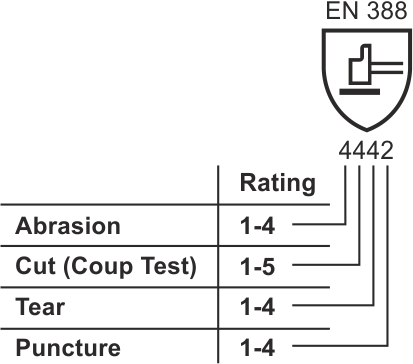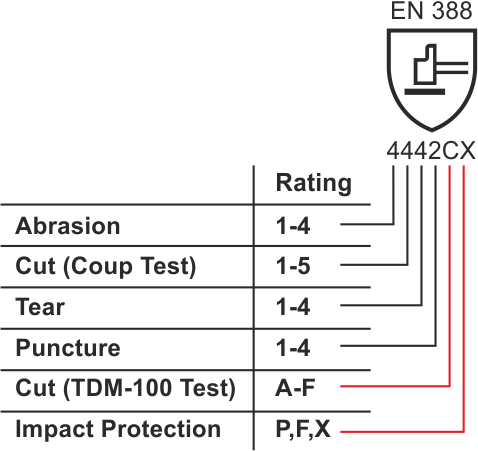European Standards for Gloves
Gloves are certified compliant with the texts and tests defining the standards indicated for each model as per guidelines.
CE category
Directive 89/686/EEC
![]()
Category I Minor risks
Category II Reversible risks
(injury), certified compliant by a notified body.
Category III Irreversible risks
(corrosion), certified compliant and tested by a notified body whose number is specified.
EN 420 General Requirement
EN 388 Mechanical Protection
| Test | Performance Levels | |||||
|---|---|---|---|---|---|---|
| 1 | 2 | 3 | 4 | 5 | ||
| a) | Abrasion resistance (cycle) | >100 | >500 | >2000 | >8000 | - |
| b) | Blade cut resistance (index) | >1.2 | >2.5 | >5 | >10.0 | >20.0 |
| c) | Tear resistance (newton) | >10 | >25 | >50 | >75 | - |
| d) | Puncture resistacne (newton) | >20 | >60 | >100 | >150 | - |
NEW EN 388 Standard & Test Method
Current Marking

New Marking

| EN 374 | Chemical Protection and Micro-organism |
| EN374-1 | (terminology and performance requirement) |
| EN374-2 | (resistance to penetration) |
| EN374-3 | (resistance to permeation by chemicals) |
EN 374-2 Micro-organisms Resistance Glove
| AQL Level | Performance Levels | AQL ≥ 2 | ||
|---|---|---|---|---|
| 4.0 | 1.5 | 0.64 | ||
EN 374-3 Low Risk Chemical Protection Glove
EN 374-3 Low Risk Chemical Protection Glove
Breakthrough times more then 30mins (levels 2) for a minimum of 3 specific chemical listed below and water proof. Therefore the letter code of the chemicals can be more than 3 letters and up to 12.
| Code | Chemical |
|---|---|
| a | Methanol |
| b | Acetone |
| c | Acetonitrile |
| b | Dichloromethane |
| e | Corbon disulpide |
| f | Toluene |
| g | Diethylamine |
| h | Tetrahydrofurane |
| i | Ethyl acetate |
| j | n-Heptate |
| k | Sodium hydroxide 40% |
| l | Sulphuric acid 96% |
EN 511 Cold Protection
| Test | Performance Levels | ||||
|---|---|---|---|---|---|
| 1 | 2 | 3 | 4 | 5 | |
| a) Resistance to convective cold | I > 0.1 | 0.1 < I < 0.15 | 0.15 < I < 0.2 | 0.22 < I < 0.3 | 0.3 < i |
| b) Resistance to contact cold | R < 0.025 | 0.025 < R < 0.05 | 0.05 < R < 0.1 | 0.1 < R < 0.15 | 0.15 < R |
| c) Permeability to water | Fail | Pass | |||
(*Fail: water penetrated after 30min; Pass: no water penetrated after 30min)
EN 407 Thermal Risk Protection
| Test | Performance Levels | ||||
|---|---|---|---|---|---|
| 1 | 2 | 3 | 4 | ||
| a) Burning behavior | ≤ 20 | ≤ 10 | ≤ 3 | ≤ 2 | |
| after burn (Times sec) | |||||
| after glow (Times sec) | N/R | ≤ 120 | ≤ 25 | ≤ 5 | |
| b) Contact heat (Temp in °C after 15 sec) | 100 | 250 | 350 | 500 | |
| c) Convective heat (heat transfer delay sec) | ≤ 4 | ≤ 7 | ≤ 10 | ≤ 18 | |
| d) Radient heat (heat transfer delay sec) | ≤ 5 | ≤ 30 | ≤ 90 | ≤ 150 | |
| e) Small splashes of molten metal (drop) | ≤ 5 | ≤ 15 | ≤ 25 | ≤ 35 | |
| f) Large splashes of molten metal (g) 30 | 30 | 60 | 120 | 300 | |
EN 60903 Electric Risk Protection
| Class (X) | Tested at Voltage | Approved for work under voltage |
|---|---|---|
| 00 | 2500 | ≥500 |
| 0 | 5000 | ≥ 1000 |
| 1 | 10000 | ≥ 7000 |
| 2 | 20000 | ≥ 17000 |
| 3 | 30000 | ≥ 26500 |
| 4 | 40000 | ≥ 36000 |
| Category (Y) | Addition Requirement |
|---|---|
| A | Acid resistance |
| H | Oil resistance |
| Z | Ozone resistance |
| M | Resistance against high mechanical strain |
| R | Oil, Ozone and high mechanical strain |
| C | Resistance against extreme cold |
EN 12477 Welding Glove
